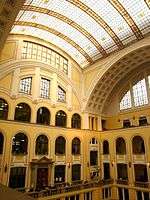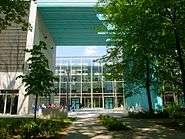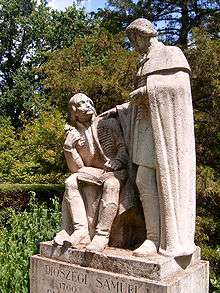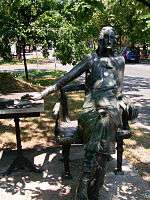University of Debrecen
| Debreceni Egyetem[1] | |
 | |
| Latin: Universitas Debreceniensis | |
| Type | Public |
|---|---|
| Established | 1538, 1912 |
| Rector | Prof. Dr. Zoltán Szilvássy |
Academic staff | 1,700 |
| Students | 32,000 |
| Address | Egyetem tér 1, 4010 Debrecen, Debrecen, Hungary |
| Affiliations | EUA |
| Website | www.unideb.hu |
 | |
The University of Debrecen (Hungarian: Debreceni Egyetem) is a university located in Debrecen, Hungary. It is the oldest continuously operating institution of higher education in Hungary (since 1538). The university has a well established programme in the English language for international students, particularly in the Medical field, which first established education in English in 1986. There are nearly 4000 international students studying at the university.[2] Until 2014 technical Academy Awards (Oscars) have been awarded to five former students.
The university also operates an associated Basic Medicine campus in Geochang County, South Korea.[3]
History
The early formation
Higher education began in Debrecen with the Calvinist College of Debrecen, which was founded in 1538. Over centuries of its existence it was one of the key institutions of higher education in Hungary. In the beginning of the 20th century the College was transformed into a university, and has a strong link and cooperation with the present Calvinist College's Debrecen Reformed Theological University.
Before, and during World War I
In 1908, the Calvinist Academy of Humanities was created, and in 1912, the Hungarian Royal University was founded. The university incorporated the theology, law, and arts faculties of the College and added a medical school. Teaching began in 1914 in the old Calvinist College buildings. In 1918, the first new medical school building was opened, and the original medical school campus was completed in 1927.
Between the two World Wars
In 1921, the university took the name of István Tisza, former prime minister of Hungary. In 1932 the university's main building was completed. It is the largest building in the city, and was designed in eclectic and neo-baroque style.

Between 1945 and 1990
In 1949/1950, the University was restructured under communist control. The primary goal of the "reorganization" was to split the university into smaller, less integrated institutions, and also to weaken or even dissolve units which did not fit to the Soviet agenda of the day. The Faculty of Theology was returned to the Calvinist College, the Faculty of Medicine became an independent university (until 2000), the Faculty of Law was discontinued, and members of the teaching staff were expelled from the University. The departments of English, French, Italian, German, and Classical Philology were closed down, while the Department of Russian expanded dramatically. The teaching of western languages resumed only after 1956, with the exception of Italian which was not offered again until the 1990s.

The Faculty of Natural Sciences became an independent faculty in 1949, and moved into the new Chemistry Building in 1970.
In 1952 the Faculty of Arts and the Faculty of Natural Sciences changed their name to Lajos Kossuth University, which they retained until 2000.
21st century
On January 1, 2000, the colleges and universities of Hajdú-Bihar county, the University of Agriculture, Lajos Kossuth University, and the Medical University, were combined. The resulting University of Debrecen had five university and three college level faculties, and 20,000 students. The Conservatory of Debrecen and schools of the University in Hajdúböszörmény and Nyíregyháza joined later.
The Debrecen Summer School, founded in 1927, is also located on campus, although it is technically independent from the university. The School teaches Hungarian culture and Hungarian as a foreign language to foreigners, year-round.
The most popular journal of the university is Egyetemi Élet ('University Life') and the leading online media of students is www.egyetemportal.hu. The university also publishes the Hungarian Journal of English and American Studies [4]
In 2005 the university was criticised and investigated after Norwegian television reported that some medical students, with the help of a few officials, were illegally smuggling body parts from the anatomy laboratories to their rooms and residences for extracurricular study. However, investigation did not confirm the television reports. No body parts were found to be missing, but an employee was disciplined for allowing students to access the laboratories after hours.[5]
Structure



Faculties and colleges
- Faculty of Agronomy
- Faculty of Arts
- Faculty of Dentistry
- Faculty of Economic Sciences
- Faculty of Medicine
- Faculty of Informatics
- Faculty of Law
- Faculty of Music
- Faculty of Pharmacy
- Faculty of Science and Technology
- Faculty of Public Health
- Faculty of Engineering
- Faculty of Child and Adult Education
Campus
- The university has two major campuses, both in Debrecen: the older main campus (virtual tour), which hosts the majority of the departments of the faculties of arts, science, informatics, medicine, music and also the botanical garden; and the younger "Kassai-road campus" where most of the buildings of the faculties of law and economy are located. However, besides these, numerous smaller units are spread across the city, for example the departments of physics and the Institute of Nuclear Research of the HAS forming a compact "mini-campus", or the Faculty of Agronomy.
Library
- The library of the University of Debrecen is the largest university library in Hungary, and one of the two national libraries of the country (the other being the National Széchényi Library in Budapest). The number of records in the library is above 6 million.
Computing
- The university hosts the largest computing cluster in Hungary (203 TFlop/s) called "Leo" (after Leo Szilard), which, as of 2015 is the 370th in the world's Top500 supercomputers.
Notable alumni and professors


- Endre Ady, poet (1877–1919)
- János Arany, writer and poet (1817–1882)
- Dezső Baltazár, reformed bishop (1871–1936)
- Ézsaiás Budai, professor of humanities and theology (1766–1841)
- Mihály Csokonai Vitéz, poet (1773–1805)
- Pál Ember Debreczeni, priest ( ? -1710)
- Sámuel Diószegi, priest, botanist (1760–1813)
- Lajos Domokos, judge, writer (1728–1803)
- Mihály Fazekas, writer, botanist (1766–1828)
- István Hatvani, mathematician (1718–1786)
- Endre Hőgyes, physician (1847–1906)
- Ferenc Kerekes, chemist, mathematician (1799–1850)
- Ferenc Kölcsey, poet and politician (1790–1838)
- Imre Lakatos, mathematician and philosopher (1922–1974)
- József Lugossy, linguist (1812–1884)
- Ferenc Medgyessy, sculptor (1881–1958)
- Zsigmond Móricz, writer (1879–1942)
- Alfréd Rényi, mathematician (1921–1970)
- Magda Szabó, writer (1917–2007)
- Sandor Szalay, physicist (1909–1987)
- Andor Szentiványi, physician (1926–2005)
- Tamás Vicsek, professor of physics
- István Weszprémi, physician (1723–1799)
- Zsuzsanna Jakab, WHO Regional Director for Europe (2010-2014; 2015-2019)
- Gyula Priskin, Academy Award winner 2010,for "Lustre",software for DI
- Tamás Perlaki, Academy Award winner 2010, "Lustre"
- Márk Jászberényi, Academy Award winner 2010, "Lustre"
- Imre Major, Academy Award winner 2014, for "Mudbox" 3-D software
- Köhegyi, Academy Award winner 2014, for "Mudbox" 3-D software
Image gallery
 Main building
Main building Solar Physics Observatory
Solar Physics Observatory Statue of István Tisza
Statue of István Tisza
See also
References
- ↑ Study in Hungary: University of Debrecen
- ↑ Study Medicine and Dentistry in Hungary
- ↑ http://www.bmckorea.org/English/main.asp
- ↑ "Hungarian Journal of English and American Studies".
- ↑ ""Dissection scandal" not to harm Hungarian degrees' recognition - officials". Hungarian television M2 satellite service, Budapest. BBC. April 29, 2005. Retrieved 29 November 2013.
External links
| Wikimedia Commons has media related to University of Debrecen. |
Coordinates: 47°33′14″N 21°37′17″E / 47.55389°N 21.62139°E